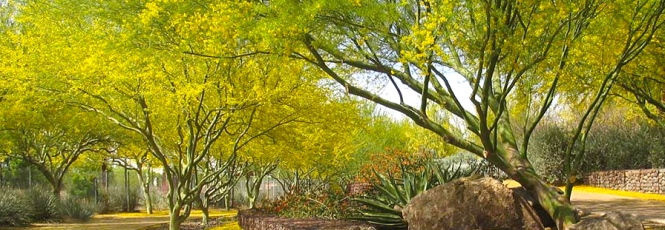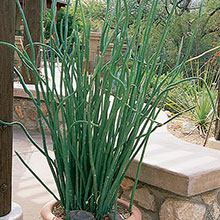Changing Landscape: Phoenix Grows Into Distinctively Desert City
Published on by Kathleen Ferris, Executive Director of Arizona Municipal Water Users Association
By Kathleen Ferris
Arizona desert cities have a distinctive style. There are few other cities where you’ll find mesquite and palo verde trees in parks, giant blue agaves and golden barrel cactus in yards, creosote and brittle bushes in medians, giant saguaros and ocotillos along the freeways. Being young cities, it took us a while to grow up and express ourselves.
Like other teenagers, there was a time when we wanted to look like everyone else. We planted Mediterranean olives and sumacs, California palms and citrus trees, and Midwest lawns and pine trees. And, like any adolescent, we didn’t smarten up overnight. It was an evolution, and sometimes a struggle, but we finally found ourselves.
Consider these City of Phoenix figures about residential landscapes. Using water consumption and other data, the city estimates that during the 1980s from 70 to 90 percent of Phoenix homes had turf landscapes. Today, that number has dropped to 10 percent.
Thirty-five years ago the old rules still applied. Deciduous trees were not for public spaces because winter visitors came to the Phoenix Metropolitan Area to see green. Palo Verde and mesquite trees looked “too hot” for visitors. Some native plants, for goodness sakes, had thorns. Neighborhood parks were to be flat, grassy, trimmed, raked and filled with evergreen trees, such as pines and sumac. Homeowners mimicked what they saw when designing their yards. Within cities, the desert was confined to preserves and botanical gardens.
It’s clear now that the 1980s marked the beginning of the end for this kind of thinking in the Valley. There was no defining moment, just a gathering of forces that led to a new perspective.
- New Breed: By the mid-1970s a new breed of architects and designers began to emerge. These young professionals considered how well projects matched their natural environments. The Southwest also was experiencing a severe drought, which helped their cause. In the desert cities, these young designers pushed the old guard’s rules for public spaces, struggling to get permission for colorful and attention grabbing desert landscape “demonstration projects.” Desert flora very slowly began appearing in city parks, around city buildings and within street medians and freeways.
 These public projects, in particular the freeways, created large-scale demand for desert nursery stock. It also gave drought tolerant and native trees and plants exposure and the opportunity to sell their beauty to commuters. People began to call the cities asking for the names of trees and plants they saw along the roadways. Then they visited their local nurseries and asked for them.
These public projects, in particular the freeways, created large-scale demand for desert nursery stock. It also gave drought tolerant and native trees and plants exposure and the opportunity to sell their beauty to commuters. People began to call the cities asking for the names of trees and plants they saw along the roadways. Then they visited their local nurseries and asked for them. - Style: This new breed of landscape architects and designers also started to attract high-end residential customers with large homes. These customers, some local celebrities, were often
 from other states and enjoyed the dramatic look of the desert. They sought out designers who could bring that colorful drama to their yards. Private desert gardens began to show up in newspapers and magazines and win prestigious landscaping awards. Premium lots now backed onto desert washes, as well as golf courses. More homeowners began asking their local nurseries for the plants they saw in these outstanding landscapes.
from other states and enjoyed the dramatic look of the desert. They sought out designers who could bring that colorful drama to their yards. Private desert gardens began to show up in newspapers and magazines and win prestigious landscaping awards. Premium lots now backed onto desert washes, as well as golf courses. More homeowners began asking their local nurseries for the plants they saw in these outstanding landscapes. - Policy: Beginning with the 1980 Arizona Groundwater Management Act, new regulations and policies reduced the amount of turf permitted in places such as parks, streetscapes and HOAs. Even golf courses and model homes were required to limit turf.
 Cities established water and desert conservation programs. Newly hired water conservation experts actively promoted the desert aesthetic. They spread the word about its beauty, its ability to attract hummingbirds and butterflies, its practicality, its water and money-saving advantages. Some cities began to offer rebates to replace turf with desert landscaping and some developed demonstration gardens to inspire homeowners. Through AMWUA, member cities shared expertise and resources, launching programs and publications to help their customers select, install and maintain desert trees and plants.
Cities established water and desert conservation programs. Newly hired water conservation experts actively promoted the desert aesthetic. They spread the word about its beauty, its ability to attract hummingbirds and butterflies, its practicality, its water and money-saving advantages. Some cities began to offer rebates to replace turf with desert landscaping and some developed demonstration gardens to inspire homeowners. Through AMWUA, member cities shared expertise and resources, launching programs and publications to help their customers select, install and maintain desert trees and plants.
 AMWUA teamed with the Arizona Nursery Association and the Arizona Landscape Contractors Association to develop and provide marketing materials and training to the industry. The industry, in turn, educated its customers about the increasingly diverse palette of desert-adapted plants available to them.
AMWUA teamed with the Arizona Nursery Association and the Arizona Landscape Contractors Association to develop and provide marketing materials and training to the industry. The industry, in turn, educated its customers about the increasingly diverse palette of desert-adapted plants available to them.
Eventually, what was once a novelty has become the norm – with room to improve.
- Designers and conservation professionals disparage too much gravel and encourage more trees and adequate plant cover.
- Untrained homeowners and landscapers can damage the potential of a desert landscape. For example, keeping desert shrubs sheared into geometric shapes results in ugly bare spots, stops them from flowering, and increases the plant’s water needs. It can eventually kill them.
- And drought-tolerant landscapes don’t always save as much water as they should save when a gardener isn’t maintaining the irrigation system or monitoring irrigation times.
We have work to do, but we’ve opened our hearts and yards to the desert. That makes us distinctive and far more water-wise. We’re growing up.
For 46 years, Arizona Municipal Water Users Association has worked to protect our member cities’ ability to provide assured, safe and sustainable water supplies to their communities. For more water information visit www.amwua.org.
1 Comment
-
In Arizona residential landscapes here is what you find:
Trees that are grossly out of scale with the small front yards. Landscape architects are obliged to "design" these plant spaces so that they look nice from the first minute, adequately filled with green matter. Unfortunately, if you plant an evergreen elm where "it seemed nice" on day one as a 24" boxed tree, like 20 feet away from the front face of the home, the tree will be touching the house in 5 years, and look stupid in 10.
Also, many of the favorites "designed" into a property are profoundly messy, dropping huge amounts of litter regularly. Many are also very fast to spread by seed into places they do not belong. The common remedies are to spray them with contact or systemic herbicide. But worse yet, the litter is gathered by noisy leaf blowers that not only ruin many neighbor's peace and quiet contentedness, but these "maintenance professionals" flip litter over the block walls, littering other's spaces, while also wreaking havoc with community air quality. The EPA notices this and cites the counties for particulate pollution, and the landscape maintenance contractors drive away to their offices to submit their weekly invoices, oblivious to the damage they have done. Not sustainable. Far from wondrous.
As an independent irrigation adviser for decades in Arizona, probably the most unrecognized error in this blog is the mention of irrigation system maintenance and monitoring irrigation times. As a contributor the the Residential Drip Irrigation Guideline by AMWUA, I have railed against a publication AMWUA calls Watering By The Numbers (WBTN). Their notion that trees should be fitted with 30 to 60 drip emitters SO THAT the desert tree can withstand 10 days between irrigation events is truly laughable. Arizona is unique, alright. Only in Arizona are the "conservationists" convinced that drip-micro irrigation isn't high frequency irrigation.
No more that 12 emitters are required for any ornamental or crop orchard tree in Arizona. Water application rates need only be 0.04 to 0.08 inches per hour, the run times need to be 10 hours in the peak use period, and irrigation runs 3 to 4 times each Summer week. That's how Arizona Department of Transportation does it, but WBTN clings to former University of Arizona icon, Dr. Jimmy Tipton, his take on this matter. Strange how one prominent irrigation equipment company, friend of the university in material ways, in Tucson, never really accepted drip-micro irrigation, which makes sense since they are biggest advocate of sprinkler irrigated turf. (Think "collapse of pork belly prices after WHO carcinogen announcement"). Another UofA researcher also decried any and all benefits of drip irrigation. This, like the promised miracles of level basin irrigation in Ag-, seems to refute the any notion of drip irrigation. It starts with proponents of "50 emitters to wet 50% of the mature canopy area (Radius: 30 feet), then added, "desert adapted tree roots extend several feet beyond the drip line", so you better add 20 or 30 more emitters for that space (Canopy radius: 40 feet). What you end up with is essentially surface irrigated trees, just like sprinklers! With that much water deposited, of course you could leave the system off for ten days. But it is totally wrongheaded thinking. Dr. Tipton, correct in nearly every other way, never adopted the esteemed irrigation expert from Netafim Ami Charitan who explained so well how small volumes stored per event only mean higher irrigation frequency; the trees adapt and rootzones (wetted onions) are much more efficient.